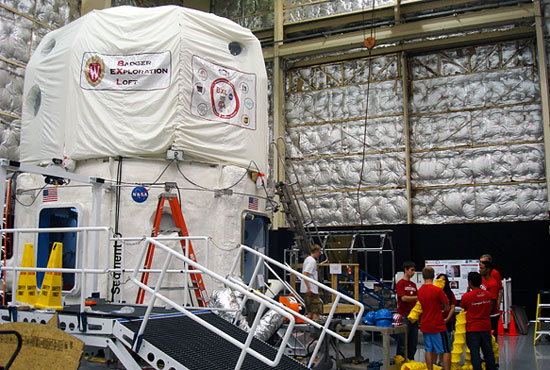UW-Madison undergrads win NASA habitat design competition

The Badger X-Loft prototype, designed by an interdisciplinary team of students studying engineering mechanics, mechanical engineering, textile and apparel design, and finance and economics, has won the NASA eXploration Habitat Academic Innovation Challenge.
Photo: courtesy Nicole Roth
It’s an inflatable home fit for an asteroid: Designing a prototype habitat that looks like a giant tent for the next generation of space explorers, an interdisciplinary team of UW–Madison undergraduate students has won the NASA eXploration Habitat Academic Innovation Challenge.
“This is a great example of how NASA can obtain innovative system concepts from universities. These technology concepts are a valuable part of our human space exploration planning activities.”
Doug Craig, strategic analysis manager for analog systems at NASA
The competition charges university teams to design and rapidly develop inflatable, habitable spaces NASA can integrate onto an existing demonstration laboratory. In September 2010, NASA named the UW–Madison Badger X-Loft team a finalist in the competition, along with teams from Oklahoma State University and the University of Maryland. The National Space Grant Foundation awarded each finalist initial funding of $48,000.
The UW–Madison team deployed and displayed its prototype at the NASA Johnson Space Center, Houston, June 20 through 24. For its win, the team receives an additional $10,000 and several members will spend September in Arizona, where they will test their habitat as part of a simulated astronaut mission to an asteroid in the annual NASA Desert Research and Technology Studies (Desert-RATS) field test.
The Badger X-Loft prototype is approximately 13 feet tall and 16 feet in diameter. Perched atop the NASA habitat demonstration unit laboratory, the habitat can house four crew members for several days and includes a desk and chair for each person, several windows styled like a ship’s portholes, and a second story “loft” with private sleeping quarters. Much of the habitat’s structure is lightweight carbon-fiber and aluminum, while the sleeping loft has a taut fabric floor. The X-Loft also is fully climate-controlled and is insulated nearly as well as a traditional house.
To give the astronauts using the X-Loft maximum flexibility, the students divided the habitat into eight equal slices and created reconfigurable spaces. “Basically, everything’s modular,” says team member Jordan Wachs, an engineering mechanics and astronautics and physics major. “The whole design was intended that any eighth can be swapped entirely with any other eighth.”
Led by Fred Elder, a UW–Madison adjunct professor of mechanical engineering and engineering physics, the team designed, built and tested its full-size prototype as part of a two-semester senior design course offered in engineering mechanics and astronautics.
Often, such design courses team up students in the same engineering field. However, the Badger X-Loft team included students studying engineering mechanics, mechanical engineering, textile and apparel design, and finance and economics.
Nicole Roth, who in May 2011 earned bachelor’s degrees in finance and economics, served as the team’s accountant. She joined the team because she saw an opportunity to gain real-world experience in her field. “I never expected to be in a student engineering project for NASA-ever,” she says. “Once we had the habitat designed, I knew we had a shot at winning.”
In addition to Roth and Wachs, other Badger X-Loft team members include Aaron Olson, Marc Fritz, Nathan Wong, Mike Lucas, Sam Marron, Max Salick, Ariel Arnson, Will Yu, Peter Sweeney, Julie Mason, Steve Wisser and Tim Feyereisen.
“This is a great example of how NASA can obtain innovative system concepts from universities,” said Doug Craig, strategic analysis manager for analog systems at NASA Headquarters in Washington. “These technology concepts are a valuable part of our human space exploration planning activities.”
Elder says the students worked countless hours, learned to take individual responsibility seriously, demonstrated leadership and initiative, remained positive and respectful of their teammates’ ideas, and displayed exceptional technical and personal skills by completing the X-Loft on time and within the original specifications. “Winning the competition made all of the long nights and difficult decisions more than worthwhile for everyone involved,” he says.
Several UW–Madison units, including the departments of Mechanical Engineering and Engineering Physics, the School of Human Ecology, Wisconsin Space Grant Consortium, and the Space Science and Engineering Center, as well as local and regional companies, provided financial and in-kind support for the project. Elder says this strong support demonstrated to NASA that the UW–Madison was serious about the competition. “We could never have been successful without this strong, early commitment, as it was clear two significant criteria for selection were an ability to leverage the NASA-supplied funds with other funds, and a demonstration that this was indeed a senior design-level course with interdisciplinary participation,” he says.
Corporate supporters include Bjorksten|Bit 7, UPS, ILC Dover, Marten Machining, Gallagher Tent and Awning, Air Distribution Concepts, and Advertising Creations.
